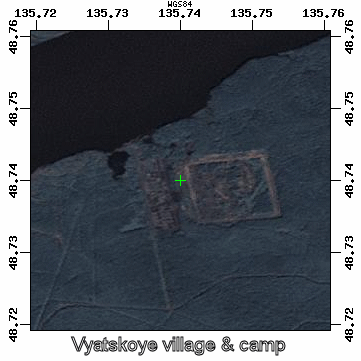
Vyatskoye
Encyclopedia

Khabarovsk Krai
Khabarovsk Krai is a federal subject of Russia , located in the Russian Far East. It lies mostly in the basin of the lower Amur River, but also occupies a vast mountainous area along the coastline of the Sea of Okhotsk, an arm of the Pacific Ocean. The administrative center of the krai is the...
, Russia
Russia
Russia or , officially known as both Russia and the Russian Federation , is a country in northern Eurasia. It is a federal semi-presidential republic, comprising 83 federal subjects...
, located on the east side of the Amur River, 70 kilometres (43.5 mi) northeast of Khabarovsk
Khabarovsk
Khabarovsk is the largest city and the administrative center of Khabarovsk Krai, Russia. It is located some from the Chinese border. It is the second largest city in the Russian Far East, after Vladivostok. The city became the administrative center of the Far Eastern Federal District of Russia...
.
History
The original inhabitants apparently were various Tungusic peoplesTungusic peoples
Tungusic peoples are the peoples who speak Tungusic languages. The word originated in Tunguska, an ill-defined region of Siberia.-Peoples:Tungusic peoples are:*Evenks*Evens*Jurchens *Manchu*Negidals...
.
Formerly part of Outer Manchuria
Outer Manchuria
Outer Manchuria , is the territory ceded by China to Russia in the Treaty of Aigun in 1858 and the Treaty of Peking in 1860. . The northern part of the area was also in dispute between 1643 and 1689...
, Vyatskoye along with Khabarovsk
Khabarovsk
Khabarovsk is the largest city and the administrative center of Khabarovsk Krai, Russia. It is located some from the Chinese border. It is the second largest city in the Russian Far East, after Vladivostok. The city became the administrative center of the Far Eastern Federal District of Russia...
and Vladivostok
Vladivostok
The city is located in the southern extremity of Muravyov-Amursky Peninsula, which is about 30 km long and approximately 12 km wide.The highest point is Mount Kholodilnik, the height of which is 257 m...
was ceded to Imperial Russia by the Qing dynasty as part of the 1860 Convention of Peking
Convention of Peking
The Convention of Peking or the First Convention of Peking is the name used for three different unequal treaties, which were concluded between Qing China and the United Kingdom, France, and Russia.-Background:...
.
During World War II
World War II
World War II, or the Second World War , was a global conflict lasting from 1939 to 1945, involving most of the world's nations—including all of the great powers—eventually forming two opposing military alliances: the Allies and the Axis...
near Vyatskoye was a camp for the Soviet 88th Brigade, which was made up of Korean and Chinese guerrillas. Kim Il-sung
Kim Il-sung
Kim Il-sung was a Korean communist politician who led the Democratic People's Republic of Korea from its founding in 1948 until his death in 1994. He held the posts of Prime Minister from 1948 to 1972 and President from 1972 to his death...
, future leader of the Democratic People's Republic of Korea, was stationed there as a Captain in the Soviet Red Army
Red Army
The Workers' and Peasants' Red Army started out as the Soviet Union's revolutionary communist combat groups during the Russian Civil War of 1918-1922. It grew into the national army of the Soviet Union. By the 1930s the Red Army was among the largest armies in history.The "Red Army" name refers to...
commanding a battalion, and according to some sources his family was there as well. According to those same sources his son Kim Jong-il
Kim Jong-il
Kim Jong-il, also written as Kim Jong Il, birth name Yuri Irsenovich Kim born 16 February 1941 or 16 February 1942 , is the Supreme Leader of the Democratic People's Republic of Korea...
was born there on February 16, 1941 (Although the DPRK government claim Kim Jong-il was born on Baekdu Mountain
Baekdu Mountain
Baekdu Mountain, also known in China as Changbai Mountain and Baitou Mountain , is a volcanic mountain on the border between North Korea and China, located at...
a year later, on February 16, 1942). Residents of the town claim that his brother Shura Kim (also known as the first Kim Pyong-il) fell into a well and died, and was buried there; however other sources claim that Kim Jong-il
Kim Jong-il
Kim Jong-il, also written as Kim Jong Il, birth name Yuri Irsenovich Kim born 16 February 1941 or 16 February 1942 , is the Supreme Leader of the Democratic People's Republic of Korea...
's sibling drowned in a pool in Pyongyang
Pyongyang
Pyongyang is the capital of the Democratic People's Republic of Korea, commonly known as North Korea, and the largest city in the country. Pyongyang is located on the Taedong River and, according to preliminary results from the 2008 population census, has a population of 3,255,388. The city was...
in 1947.


